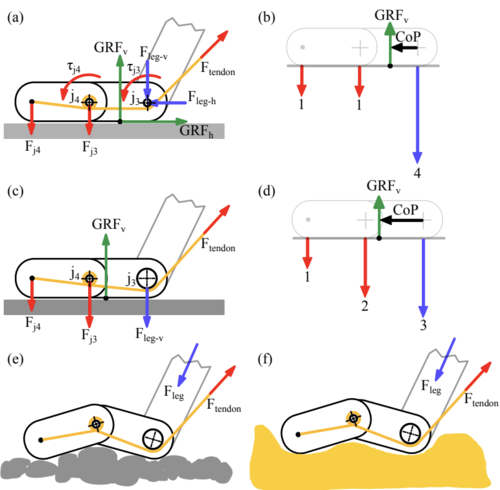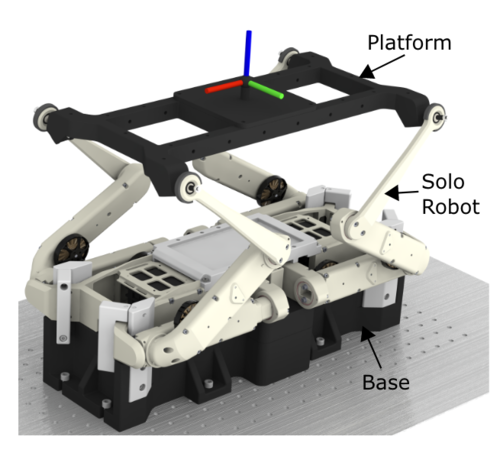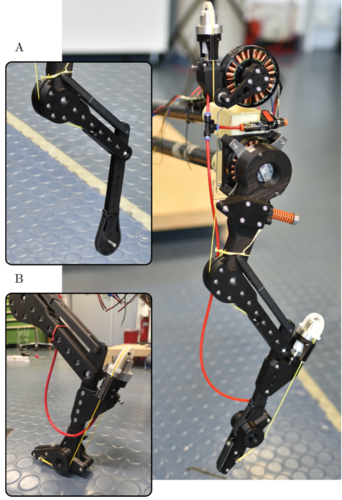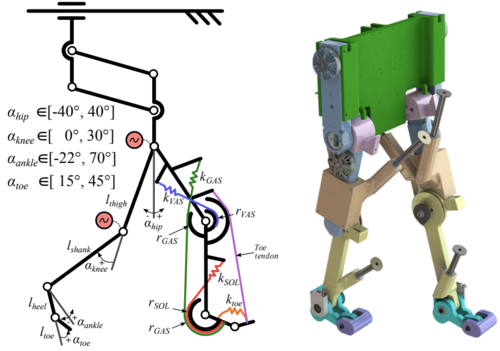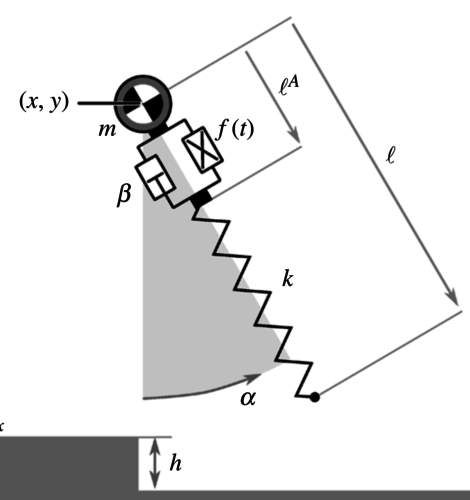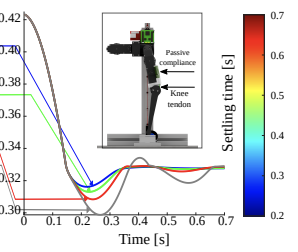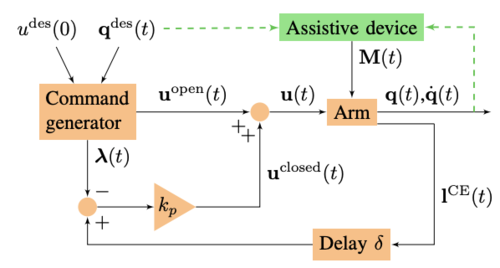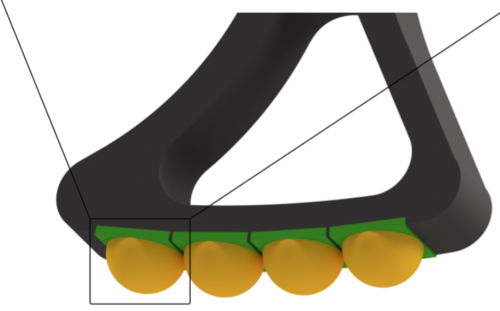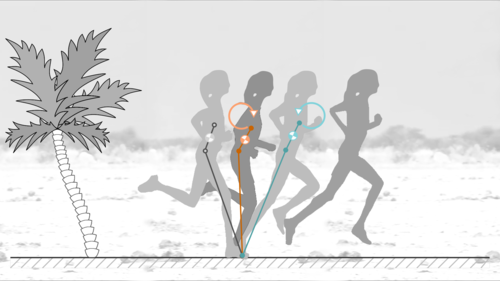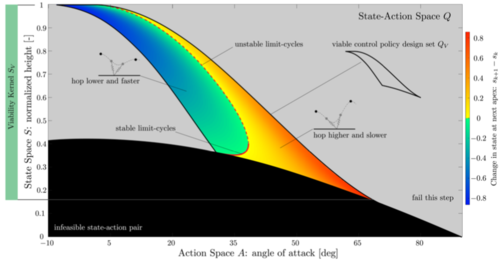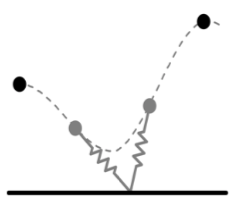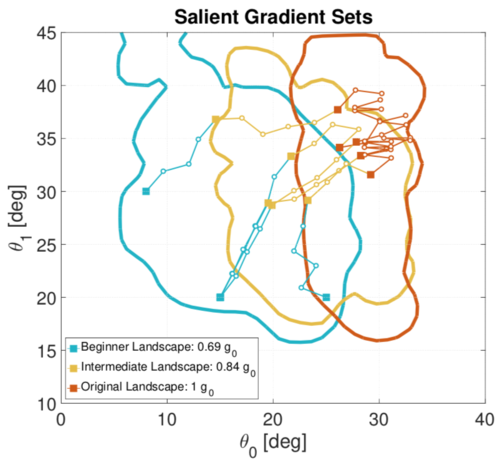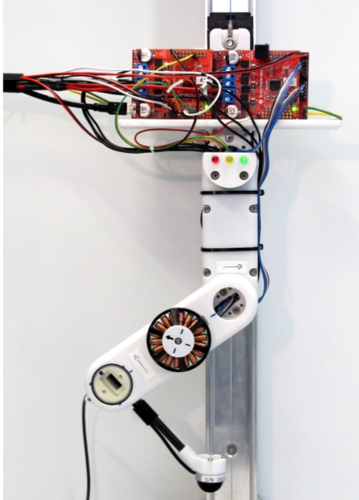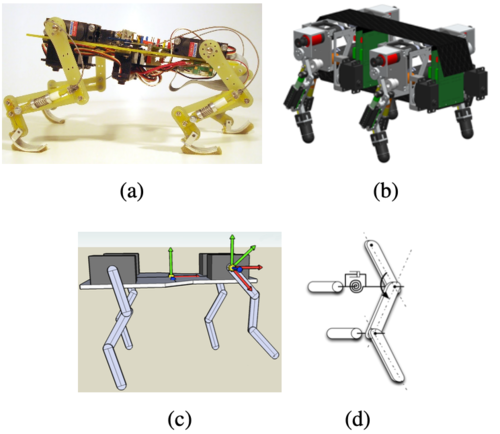2023
Multi-segmented Adaptive Feet for Versatile Legged Locomotion in Natural Terrain
(Outstanding locomotion paper award)
Chatterjee, A., Mo, A., Kiss, B., Goenen, E. C., Badri-Spröwitz, A.
2023 IEEE International Conference on Robotics and Automation (ICRA 2023), pages: 1162-1169 , IEEE, Piscataway, NJ, IEEE International Conference on Robotics and Automation (ICRA), June 2023 (conference)
Upside down: affordable high-performance motion platform
Pradhan, N. M. S., Frank, P., Mo, A., Badri-Spröwitz, A.
arXiv, 2023 (conference) Accepted
2022
Diaphragm Ankle Actuation for Efficient Series Elastic Legged Robot Hopping
Bolignari, M., Mo, A., Fontana, M., Badri-Spröwitz, A.
2022 IEEE/RSJ International Conference on Intelligent Robots and Systems (IROS), IEEE, IROS2022, October 2022 (conference) In press
Gastrocnemius and Power Amplifier Soleus Spring-Tendons Achieve Fast Human-like Walking in a Bipedal Robot
Kiss, B., Gonen, E. C., Mo, A., Buchmann, A., Renjewski, D., Badri-Spröwitz, A.
2022 IEEE/RSJ International Conference on Intelligent Robots and Systems (IROS), IEEE, IROS2022, October 2022 (conference) In press
Power to the springs: Passive elements are sufficient to drive push-off in human walking
Buchmann, A., Kiss, B., Badri-Spröwitz, A., Renjewski, D.
In Robotics in Natural Settings , pages: 21-32, Lecture Notes in Networks and Systems, 530, (Editors: Cascalho, José M. and Tokhi, Mohammad Osman and Silva, Manuel F. and Mendes, Armando and Goher, Khaled and Funk, Matthias), Springer, Cham, 25th International Conference on Climbing and Walking Robots and the Support Technologies for Mobile Machine (CLAWAR 2022), August 2022 (inproceedings)
2021
A little damping goes a long way
Heim, S., Millard, M., Mouel, C. L., Badri-Spröwitz, A.
In Integrative and Comparative Biology, 61(Supplement 1):E367-E367, Oxford University Press, Society for Integrative and Comparative Biology Annual Meeting (SICB Annual Meeting 2021) , March 2021 (inproceedings)
Effects of tendon-network mechanisms on avian terrestrial locomotion
Contreras, F. B., Daley, M., Badri-Spröwitz, A.
In Integrative and Comparative Biology, 61(Supplement 1):E89-E90, Oxford University Press, Society for Integrative and Comparative Biology Annual Meeting (SICB Annual Meeting 2021), January 2021 (inproceedings)
Developing a mechanical model for intraspinal mechanosensing in avians
Mo, A., Kamska, V., Contreras, F. B., Daley, M., Badri-Spröwitz, A.
In Integrative and Comparative Biology , 61(Supplement 1):E618-E619, Oxford University Press, Society for Integrative and Comparative Biology Annual Meeting (SICB Annual Meeting 2021), January 2021 (inproceedings)
Associating functional morphology of the lumbosacral organ and locomotion modalities in avians
Kamska, V., Contreras, F. B., Daley, M., Badri-Spröwitz, A.
In Integrative and Comparative Biology, 61(Supplement 1):E437-E437, Oxford University Press, Society for Integrative and Comparative Biology Annual Meeting (SICB Annual Meeting 2021), January 2021 (inproceedings)
Tackling sensorimotor delays and low control update frequencies during drop impacts with hybrid parallel leg compliance
Ashtiani, M. S., Sarvestani, A. A., Badri-Spröwitz, A.
The 9.5th international symposium on Adaptive Motion of Animals and Machines. Ottawa,Canada (Virtual Platform). 2021-06-22/25. Adaptive Motion of Animals and Machines Organizing Committee., pages: 3, Adaptive Motion of Animals and Machines Organizing Committee, Adaptive Motion of Animals and Machines, 2021 (conference)
2020
Simulating the response of a neuro-musculoskeletal model to assistive forces: implications for the design of wearables compensating for motor control deficits
Stollenmaier, K., Rist, I., Izzi, F., Haeufle, D. F.
In 2020 8th IEEE RAS/EMBS International Conference for Biomedical Robotics and Biomechatronics (BioRob 2020), pages: 779-784, IEEE, Piscataway, NJ, 8th IEEE RAS/EMBS International Conference for Biomedical Robotics and Biomechatronics (BioRob 2020), October 2020 (inproceedings)
FootTile: a Rugged Foot Sensor for Force and Center of Pressure Sensing in Soft Terrain
Ruppert, F., Badri-Spröwitz, A.
In 2020 IEEE International Conference on Robotics and Automation (ICRA 2020), pages: 4810-4816, IEEE, Piscataway, NJ, IEEE International Conference on Robotics and Automation (ICRA 2020) , 2020 (inproceedings)
2019
Trunk Pitch Oscillations for Joint Load Redistribution in Humans and Humanoid Robots
Drama, Ö., Badri-Spröwitz, A.
Proceedings of 2019 IEEE-RAS 19th International Conference on Humanoid Robots, pages: 531-536, IEEE, Humanoids, October 2019 (conference)
The positive side of damping
Heim, S., Millard, M., Le Mouel, C., Sproewitz, A.
Proceedings of AMAM, The 9th International Symposium on Adaptive Motion of Animals and Machines, August 2019 (conference)
Quantifying the Robustness of Natural Dynamics: a Viability Approach
Heim, S., Sproewitz, A.
Proceedings of Dynamic Walking , Dynamic Walking , 2019 (conference)
2018
Learning from Outside the Viability Kernel: Why we Should Build Robots that can Fail with Grace
Heim, S., Sproewitz, A.
Proceedings of SIMPAR 2018, pages: 55-61, IEEE, 2018 IEEE International Conference on Simulation, Modeling, and Programming for Autonomous Robots (SIMPAR), May 2018 (conference)
Shaping in Practice: Training Wheels to Learn Fast Hopping Directly in Hardware
Heim, S., Ruppert, F., Sarvestani, A., Sproewitz, A.
In Proceedings of the IEEE International Conference on Robotics and Automation (ICRA) 2018, pages: 5076-5081, IEEE, International Conference on Robotics and Automation, May 2018 (inproceedings)
2017
Scalable Pneumatic and Tendon Driven Robotic Joint Inspired by Jumping Spiders
Sproewitz, A., Göttler, C., Sinha, A., Caer, C., Öztekin, M. U., Petersen, K., Sitti, M.
In Proceedings 2017 IEEE International Conference on Robotics and Automation (ICRA), pages: 64-70, IEEE, Piscataway, NJ, USA, IEEE International Conference on Robotics and Automation (ICRA), May 2017 (inproceedings)
Linking Mechanics and Learning
Heim, S., Grimminger, F., Drama, Ö., Spröwitz, A.
In Proceedings of Dynamic Walking 2017, 2017 (inproceedings)
Is Growing Good for Learning?
Heim, S., Spröwitz, A.
Proceedings of the 8th International Symposium on Adaptive Motion of Animals and Machines AMAM2017, 2017 (conference)
2011
Oncilla Robot—A Light-weight Bio-inspired Quadruped Robot for Fast Locomotion in Rough Terrain
Spröwitz, A., Kuechler, L., Tuleu, A., Ajallooeian, M., D’Haene, M., Moeckel, R., Ijspeert, A. J.
Symposium on adaptive motion of animals and machines (AMAM 2011), January 2011 (conference)

